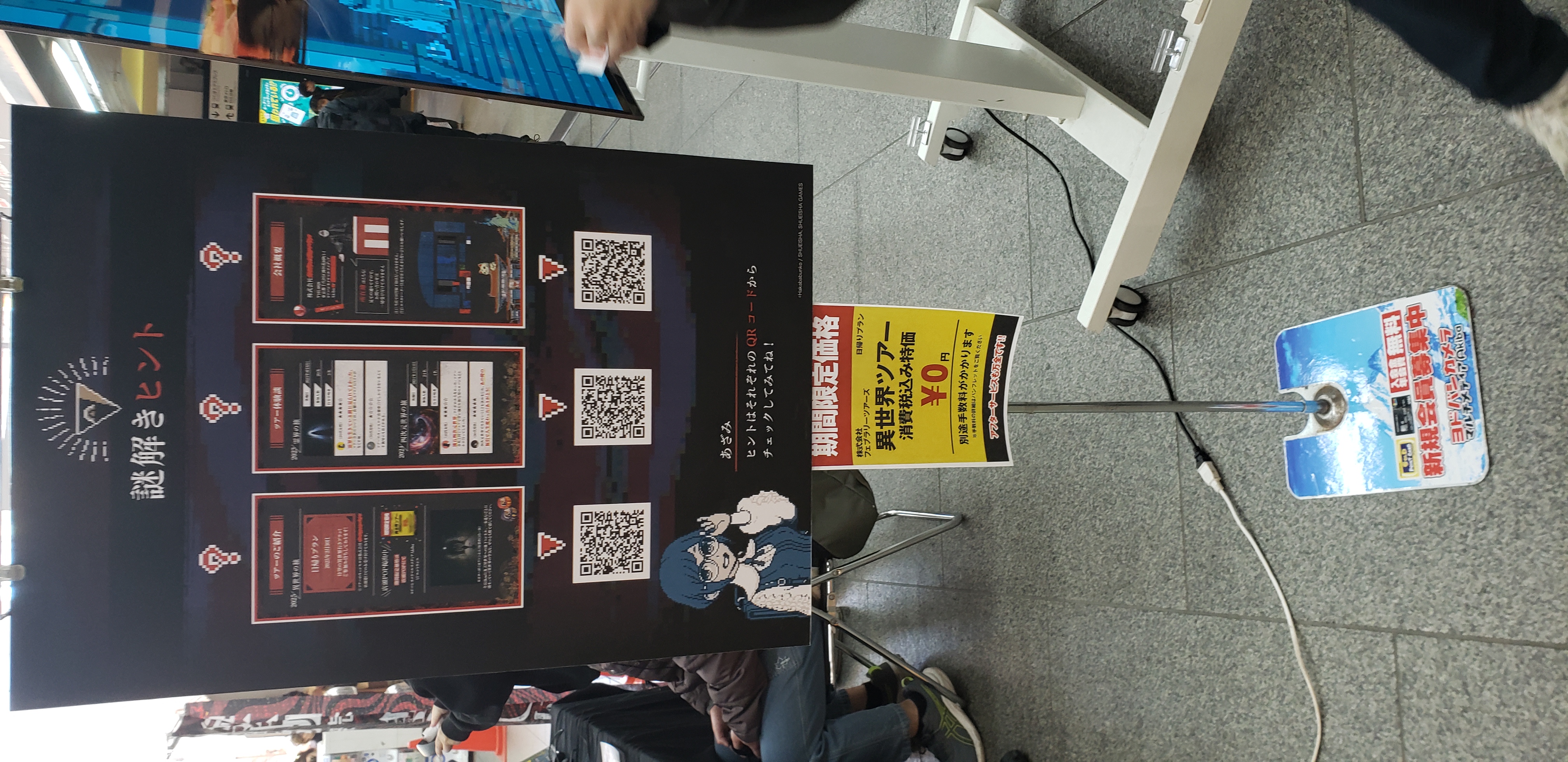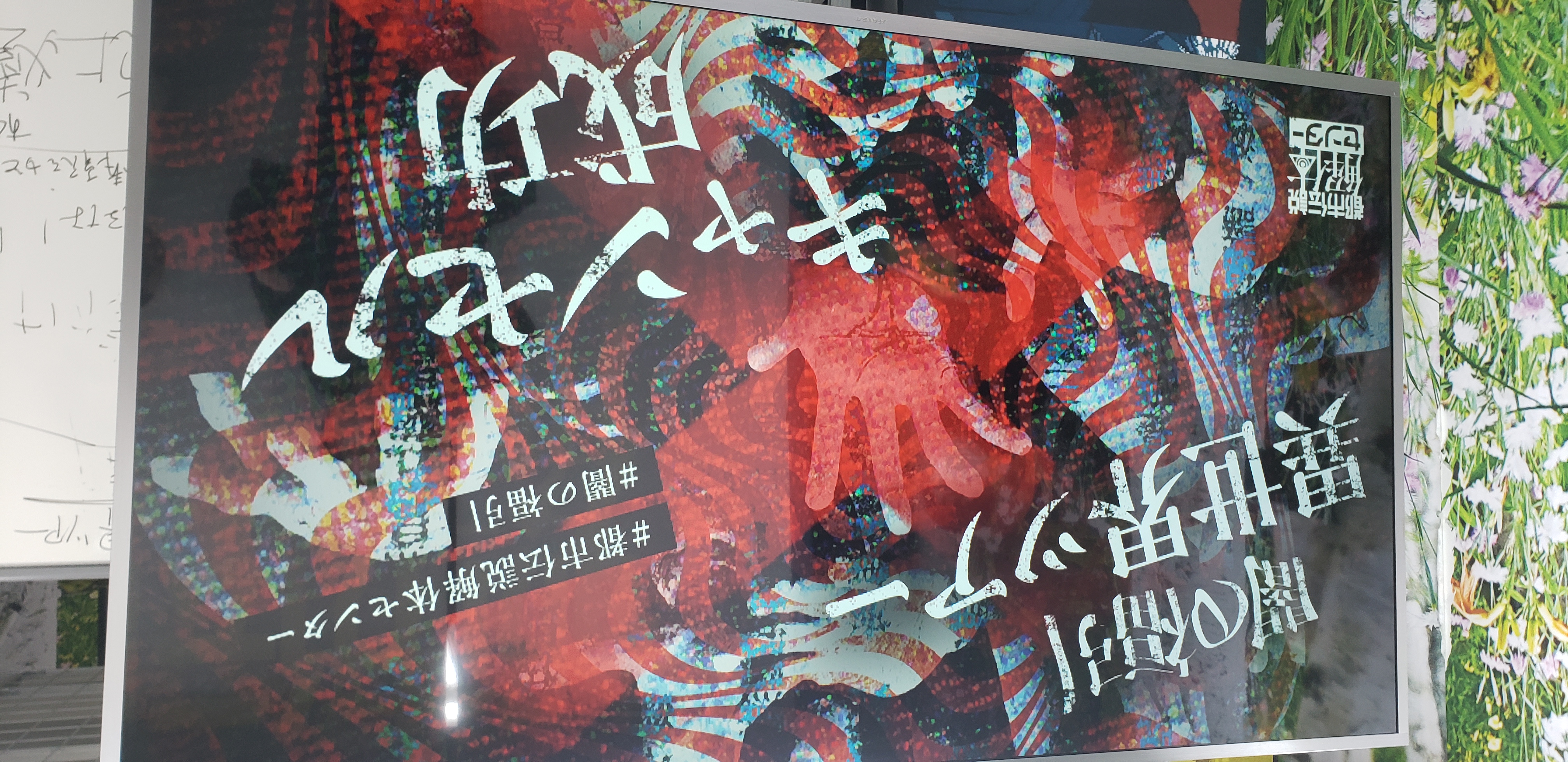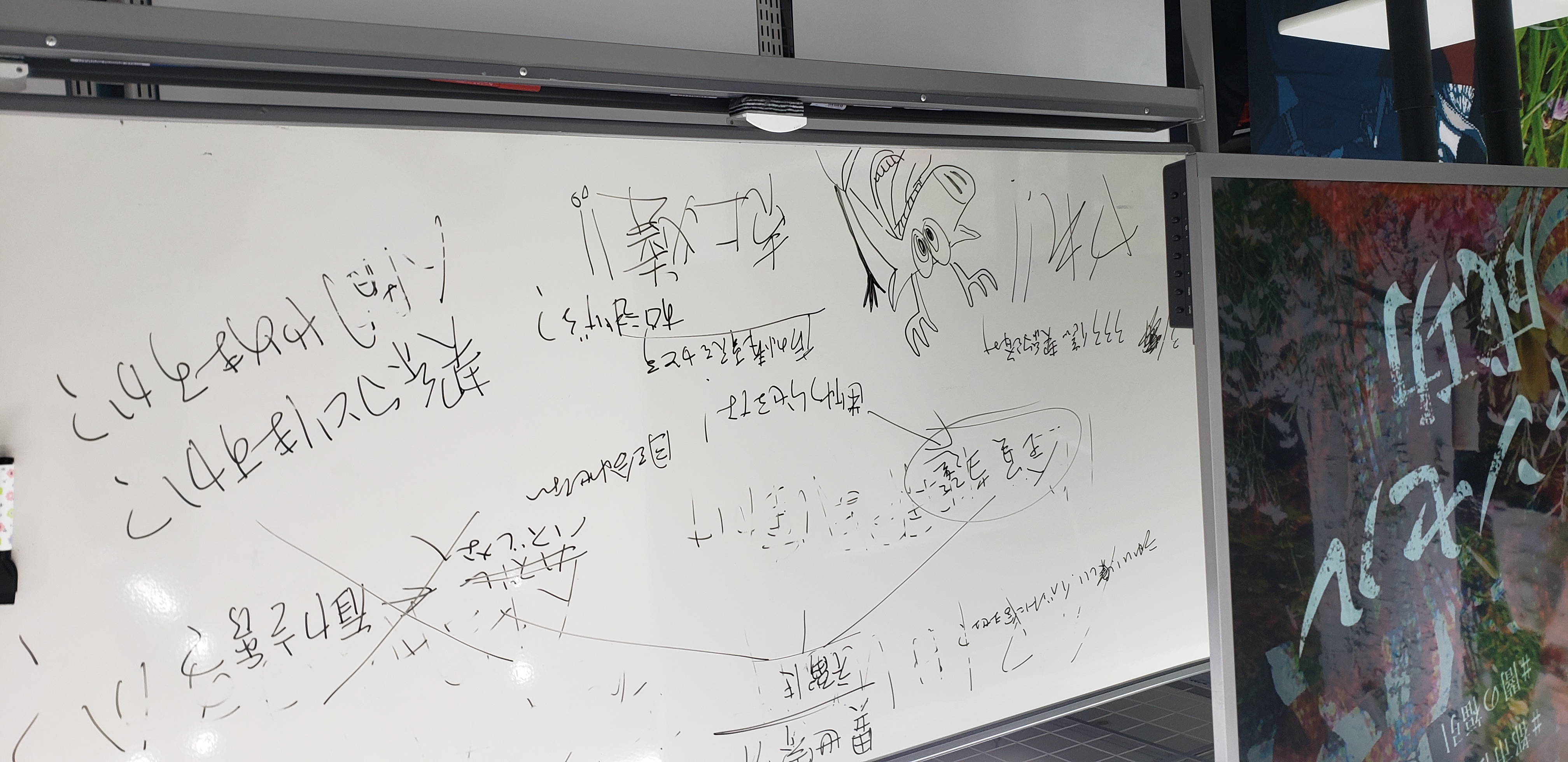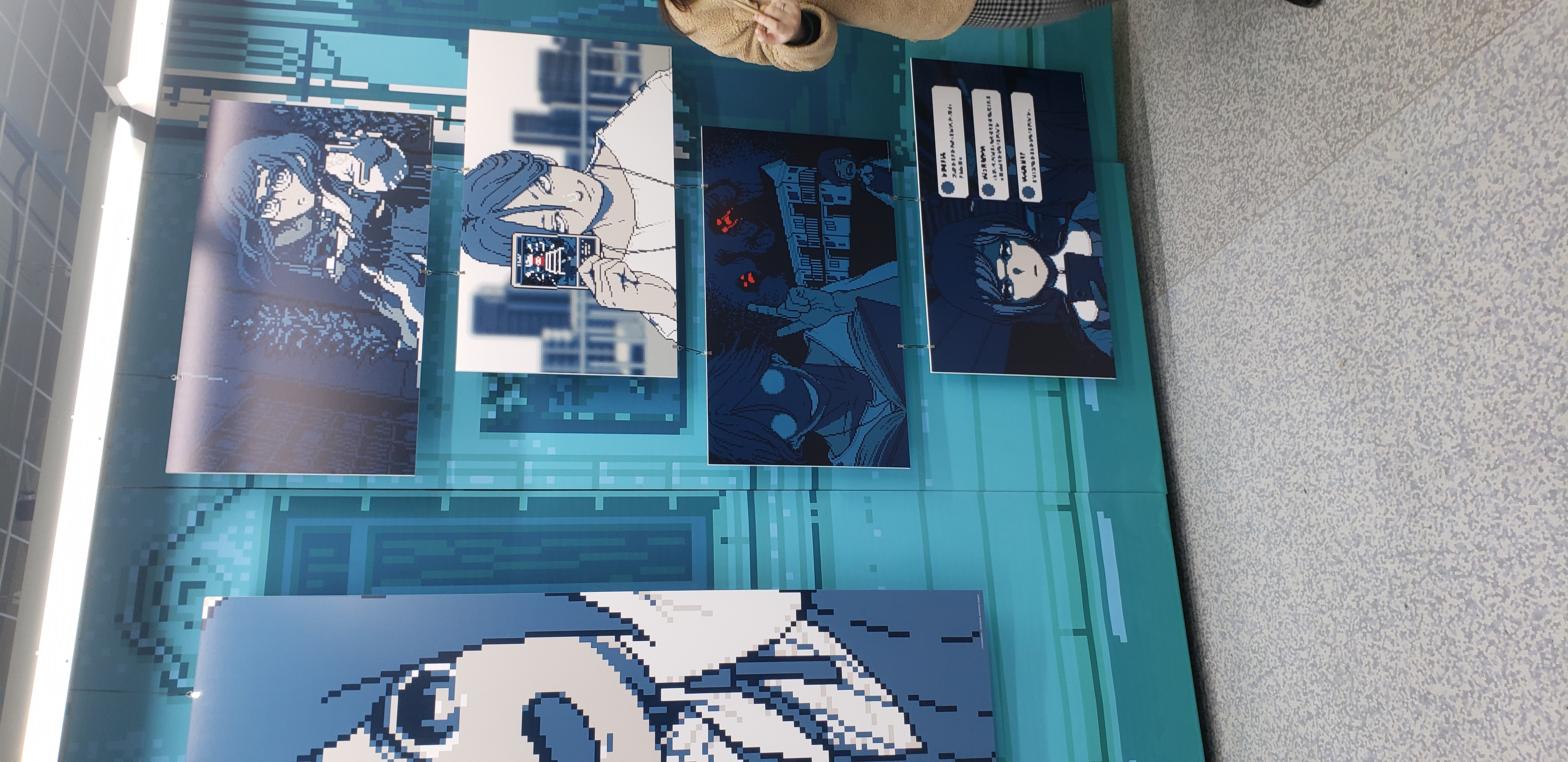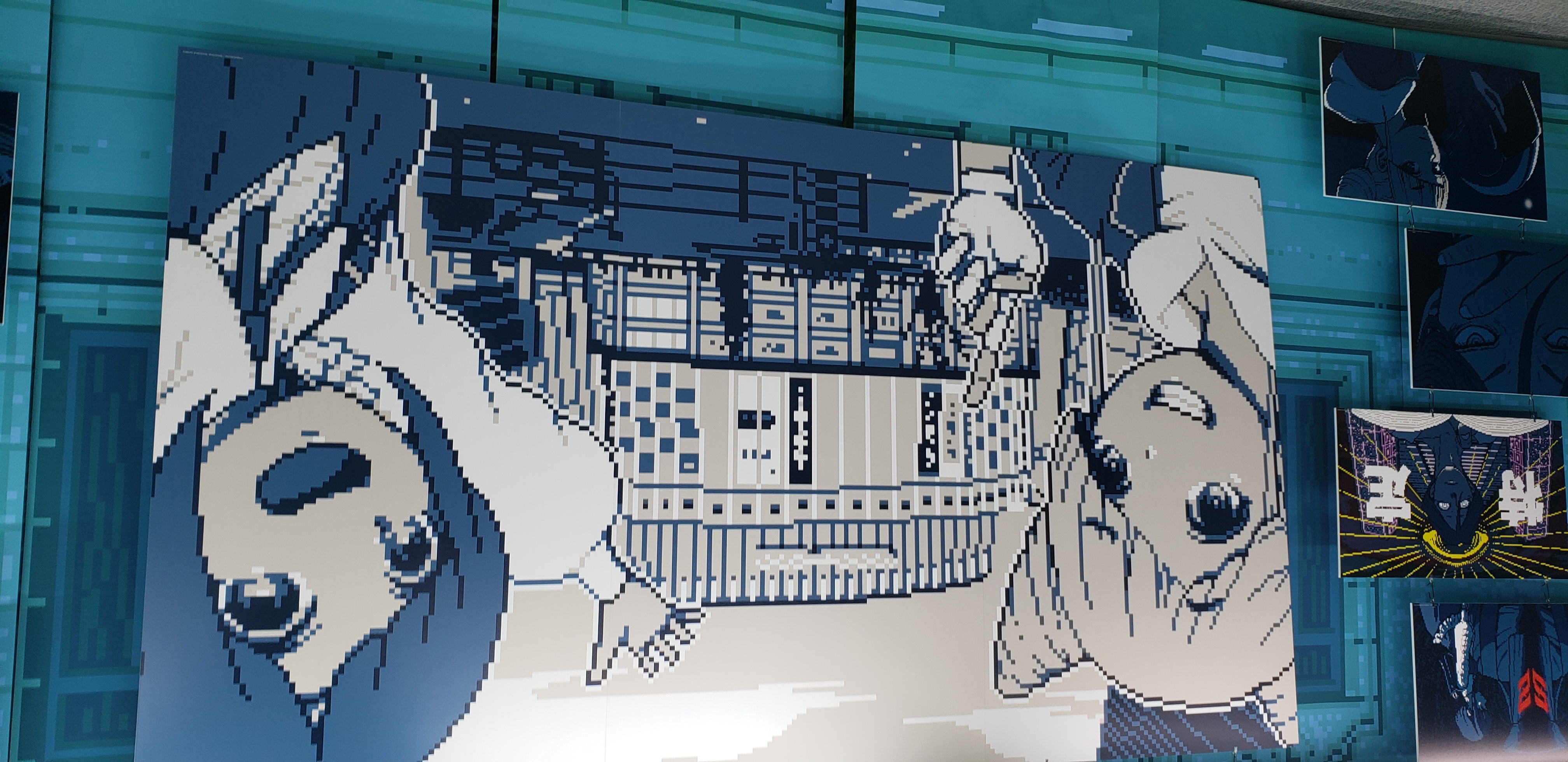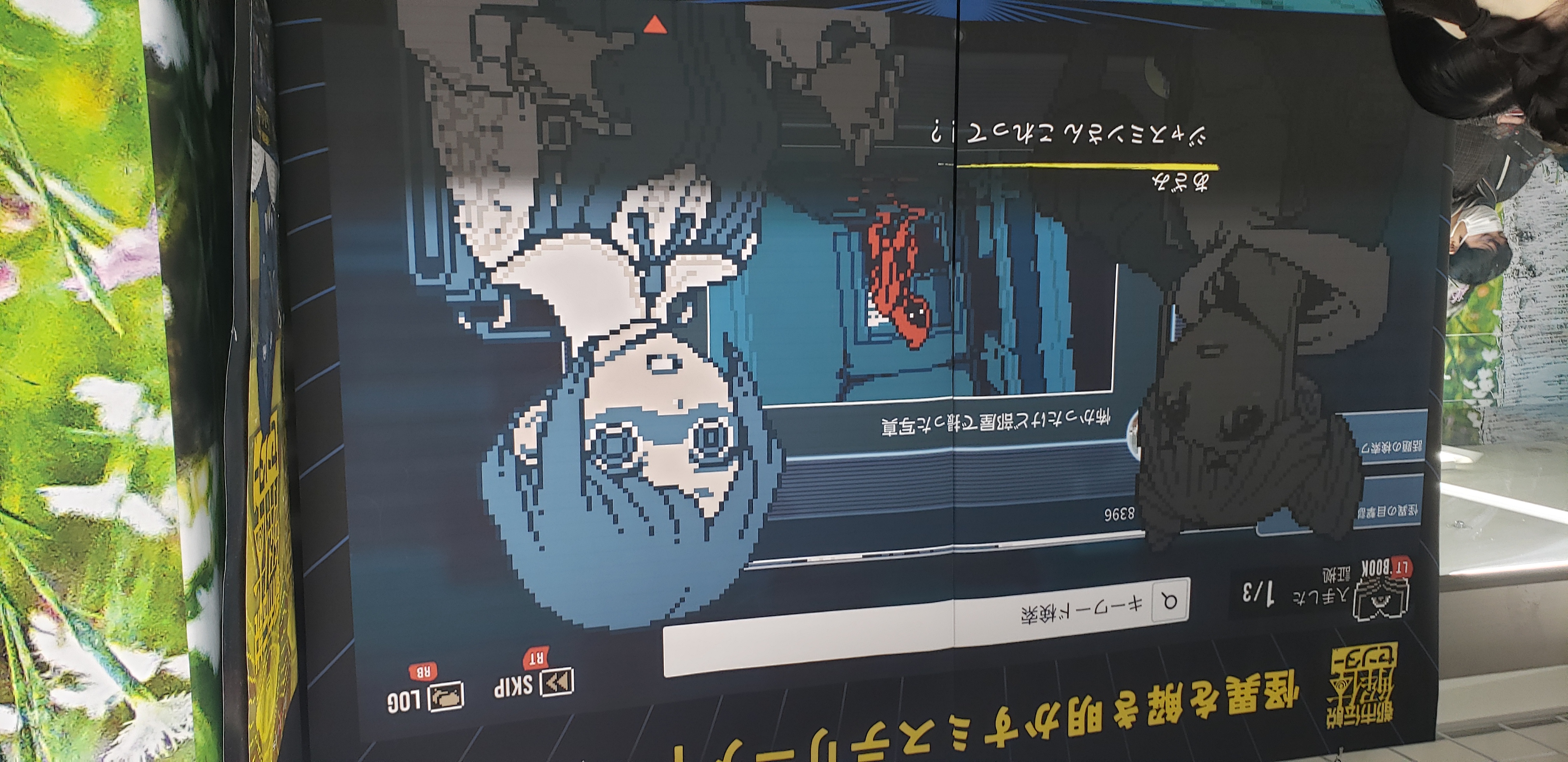Toshikai's a pretty good game, innit?
Posted 2025-03-10 20:47 JSTFirst, though, lemme tell you about its promo event
On Valentine's Day this year, a little game whose name got localized as Urban Myth Dissolution Center came out, and a week later, they held a cute little promotional event at Yodobashi Camera in Akihabara. I'd already kinda had my eye on this game from advertisements I'd seen, so I figured I'd go check it out. If you don't care about the event and just want to see what I think about the game, click here.
They had a little area where you could sit and demo the game for half an hour, but the virtual queue for that was long since full by the time I approached the guy managing it. Next to that, however, was a "Raffle of Darkness" where you could spin one of those little contraptions you see in Japanese shopping streets for a chance to win a prize. I didn't take a picture of the table for that itself because I didn't want to get people in the shot, but here's a picture of a cardboard cutout of Meguriya I snapped while I was standing in line:
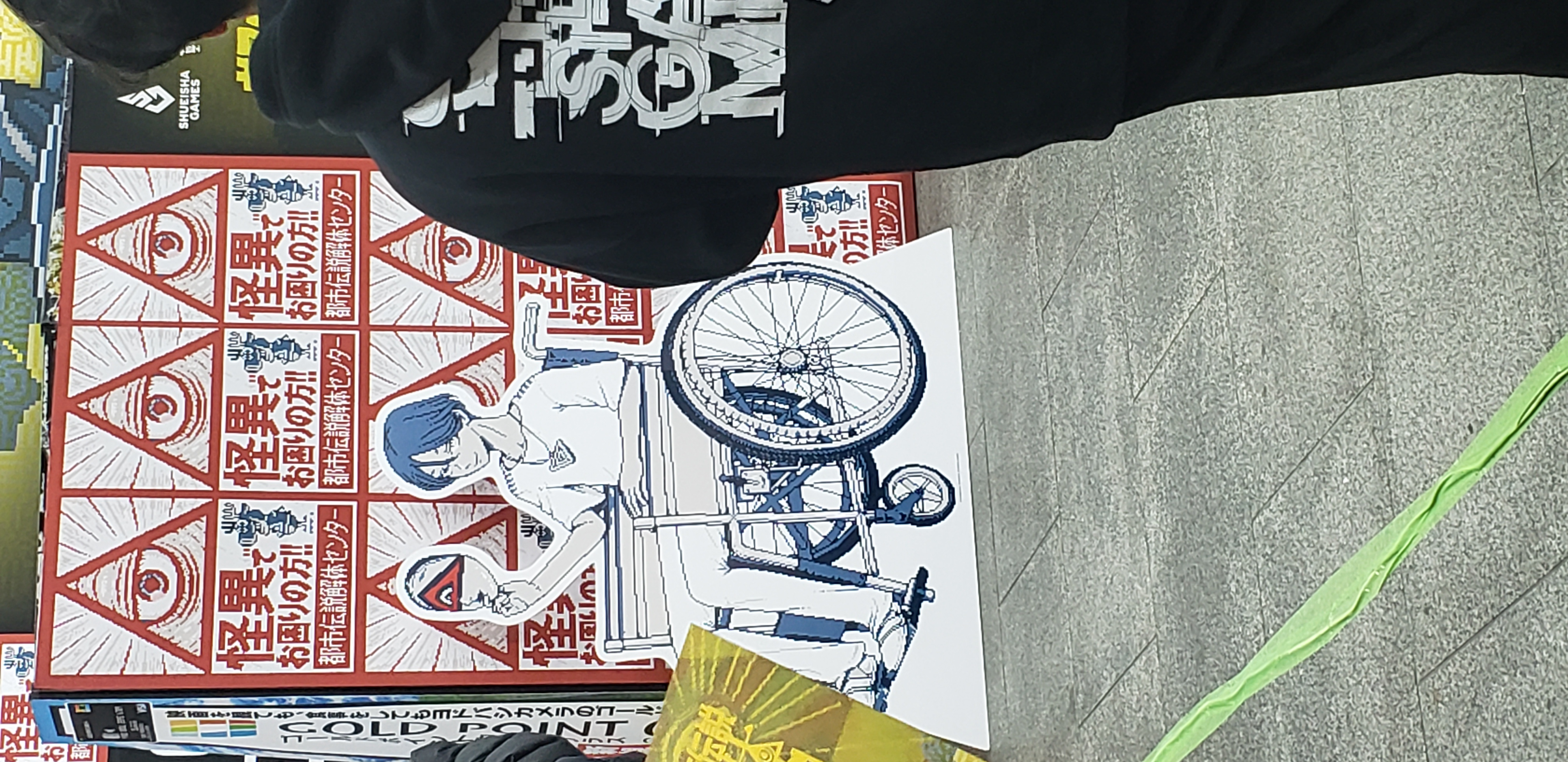
They had the raffle rigged so that everyone won the grand prize: a free day trip to another world, processing fees apply separately. They gave you this brochure to guide you:
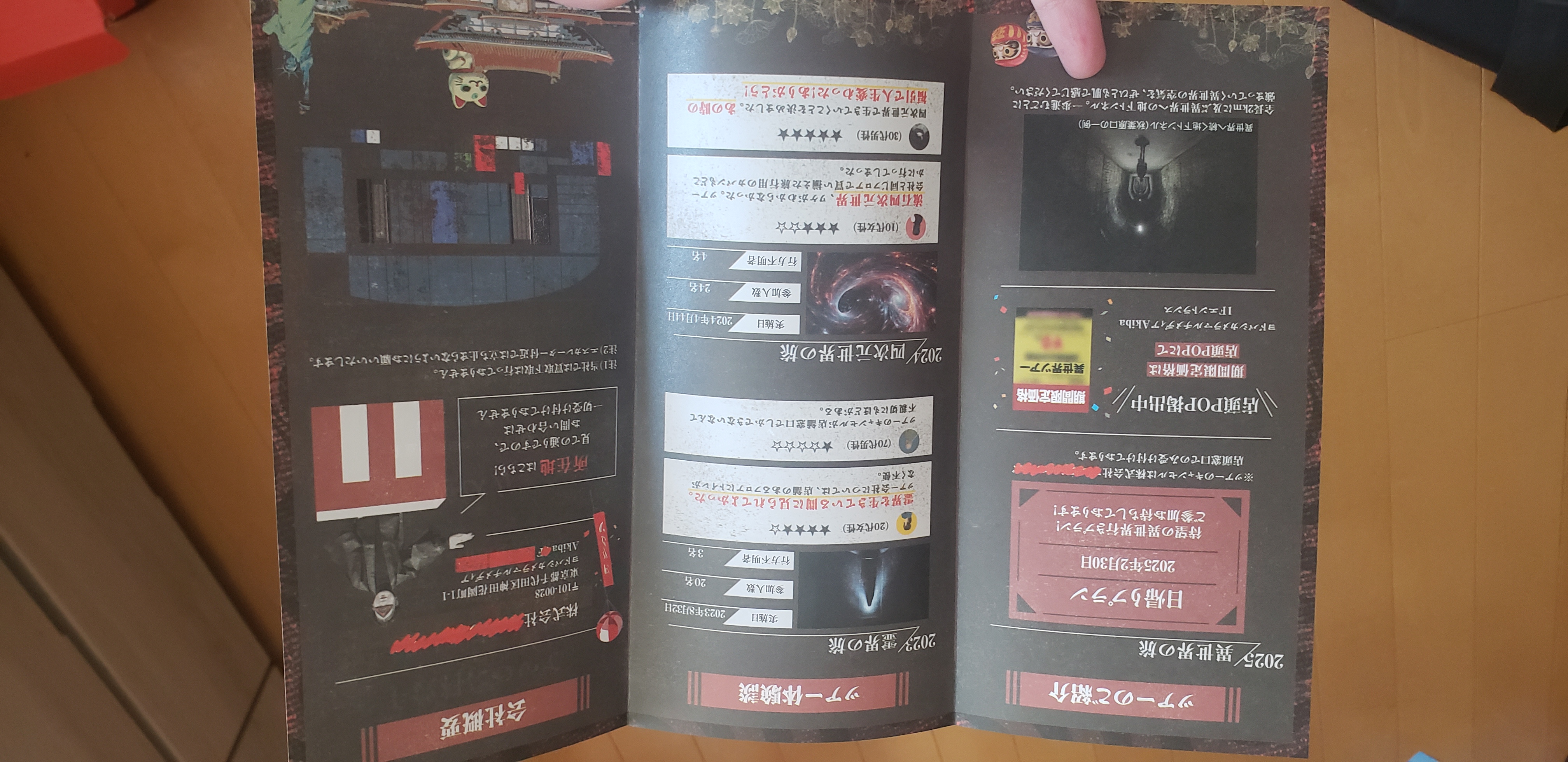
However, if you scrutinize the brochure, you realize that the "processing fees" for your free trip come out to "the remainder of your life in this world." Ruh-roh! Better tell them you want to cancel... which you can only do by visiting the company's office in Yodobashi Camera in person. But the brochure doesn't tell you the company name (it's blotted out), and it's unclear as to the exact location of the office in the building. You have three things to investigate in this ARG: the company's name, what floor it's on, and where it is on that floor. Near the raffle, they have a few QR codes to help you:
The QR codes take you to PDFs of conversations between Toshikai's protagonist, Azami, and her boss, Meguriya, about the puzzle in question. They're meant to be hints, but they really all but spell the answers out. The ARG was only really a challenge if you didn't use the hints. For example, the first mystery is the tour company's name. It's blotted out wherever it appears in the brochure, and in the hint PDF, Meguriya remarks that you'd just have to find it somewhere else. But take another look at that picture of the poster with the QR codes. See that yellow paper taped to the bottom? That's a price listing that you could find a million of all over Yodobashi Camera, so you're liable not to pay it much heed, but look again. It's the price listing for the tour shown on the left page of the brochure! And if you look closely, you can see that the company's name is February Tours, Inc. One mystery down!
The middle page of the brochure indicates what floor the company office is on. As Meguriya points out in the hints, two customer reviews stand out: one complaining that there was no bathroom on the same floor as the office, and one remarking how they bought a suitcase for their trip without changing floors after they left the office. If you look at Yodobashi Camera's floor catalog, you'll find that the only floor that meets both those criteria is the second floor.
But where on the second floor is the office? The answer to that lies hidden on the right page of the brochure, which has an unlabeled floor plan with three areas marked in red. The office must be one of those three areas, but which? Meguriya to the rescue again: he points out that the fine print asks readers not to stand near the escalators and informs them that they don't do trade-ins. So the office must not be the trade-in counter or the area in front of the escalators. That just leaves, and you're never gonna believe this, the event space. Your destination in this incredibly easy ARG is the pop-up office of February Tours, Inc. in the event space on the second floor of Yodobashi Camera!
I'll give them some credit, though: from the outside, the event space doesn't look like it has anything to do with Toshikai. They have a sign for February Tours, Inc. out front, but it doesn't have any of the game's aesthetic or branding. They have a guy standing outside, and if you show him your brochure and tell him you want to cancel, you get to join a line. They take four or five people at a time, leading you into the event space, which is a giant photo op for Toshikai available even if you aren't doing the ARG, and behind a wall to talk to the CEO of February Tours, Inc.
He's a shady-looking guy, complete with actual shades despite being indoors. The four or five of you tell him you want to cancel your trips.
"Ah, man, are you sure?" he asks reluctantly. "Is there anything I can do to talk you out of it?"
You're sure. You really do want to cancel.
He hems and haws again. "Oh, but it's not a sure thing if you'll be able to," he mumbles. "You sure you wanna take the chance?"
You say yes, and lo and behold, you get to cancel your trip. They hand you a little fake newspaper article about February Tours, Inc. getting shut down:
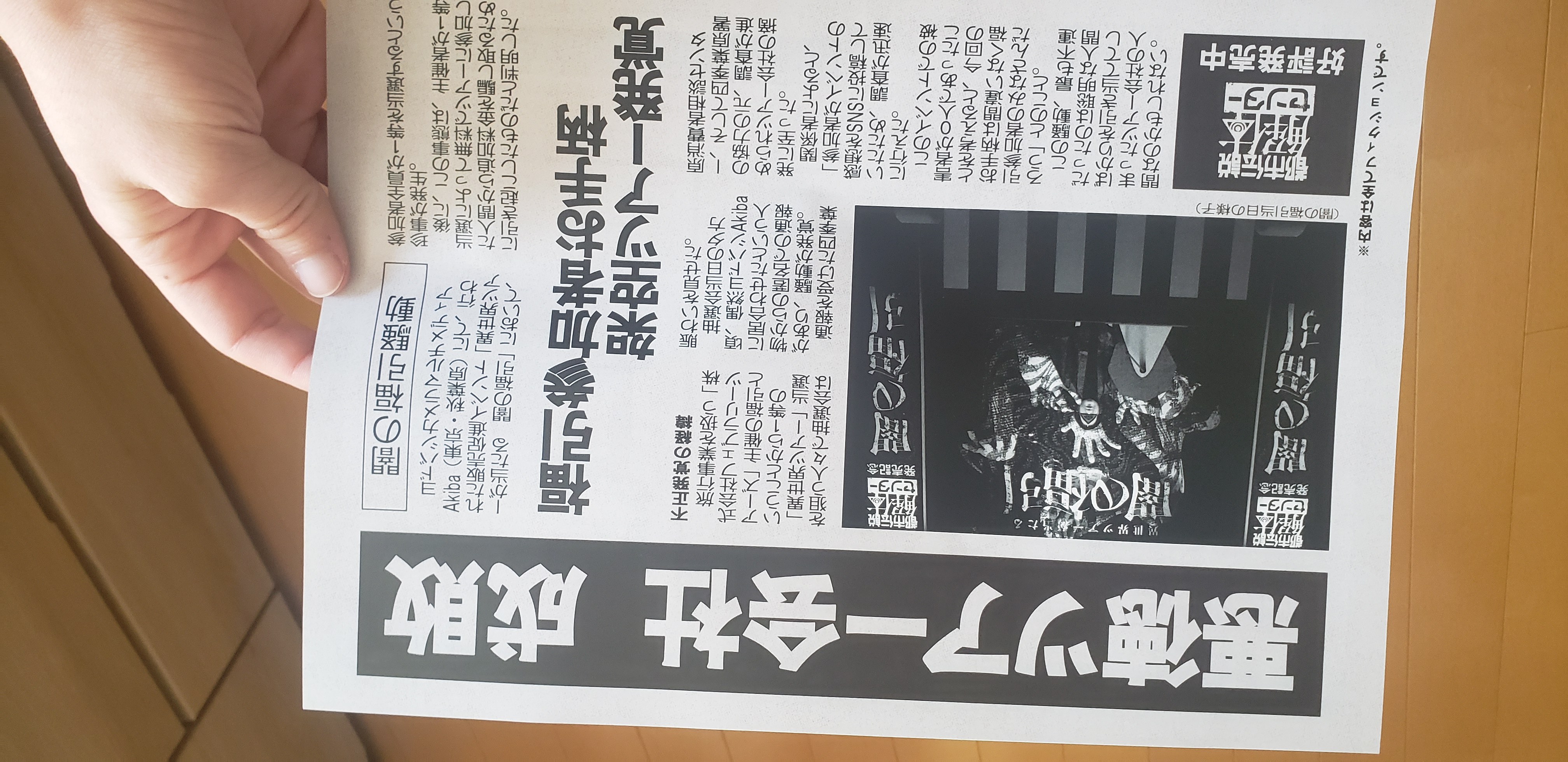
On the back is an explanation of the puzzles you had to solve to get there in the first place, but one thing did surprise me: there was a shortcut. I didn't show you, but one of the out-of-character pages of the brochure, the one explaining the rules of the ARG, was bordered in a design containing dots and dashes, which turned out to be Japanese Morse code for "second floor event space." Clever!
While you're back there behind that wall, you also get to take pictures of a big ol' board congratulating you on canceling your trip...
...and a whiteboard about their little scheme:
Once you're done, they show you back out to the main event space, which has a bunch of blown-up CGs from the game...
...as well as one original one:
And then one more promotional image they threw together...
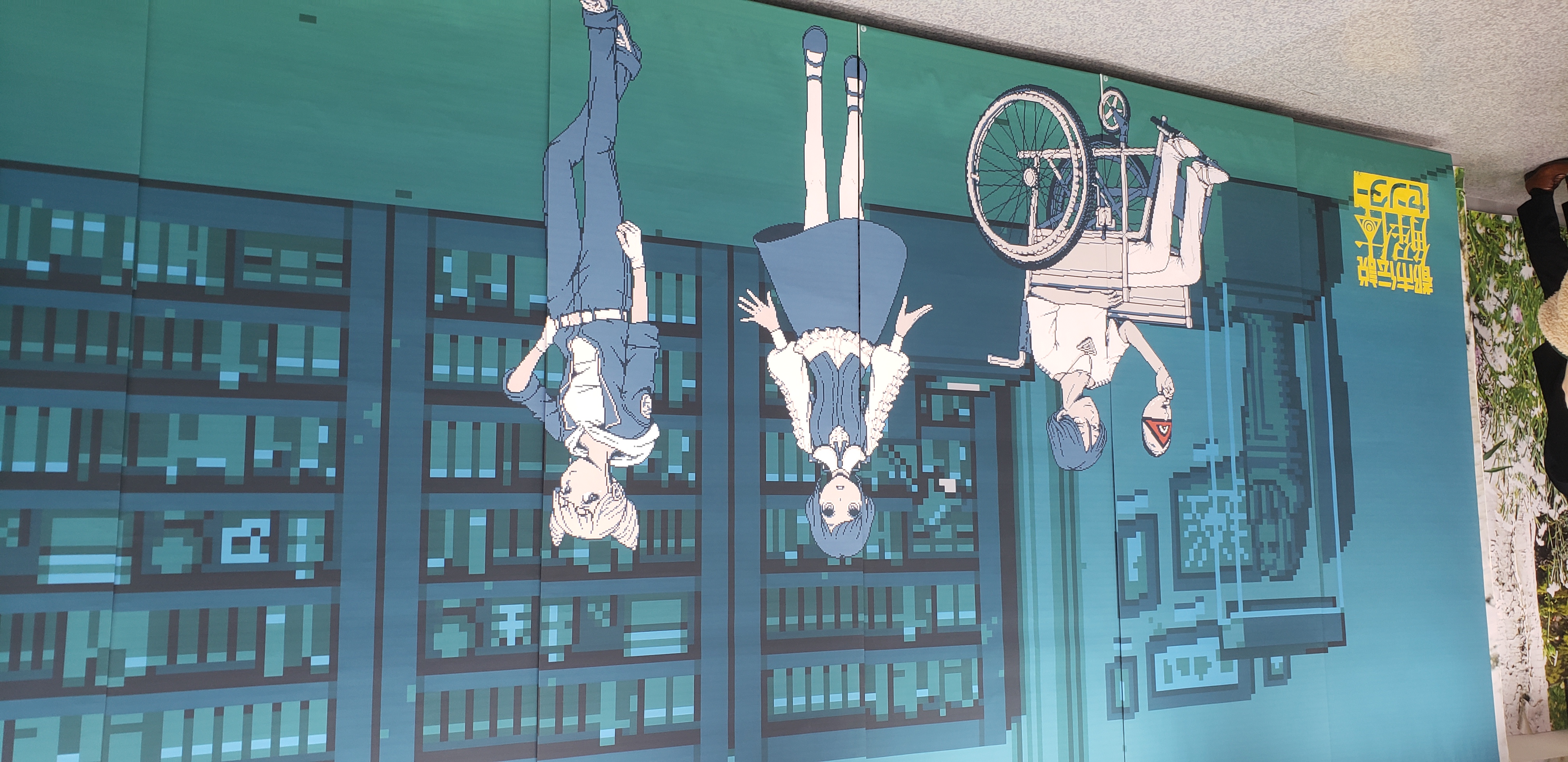
...and a really huge screenshot from the game for good measure:
By the way, that image of Azami and Jasmine taking a selfie in front of Yodobashi Camera was also on a clear file folder they gave you for solving the ARG, which I thought was nice. You know, for all the throngs of people out there who still have so many paper documents they need to keep them in folders.
This little ARG wasn't exactly challenging, but I had enough fun with it, and the game turned out to be half the price I was afraid it would be, so I figured I'd pick it up. Unfortunately for me, Yodobashi Camera had sold out of the Switch version in the time I'd spent faffing about with the ARG, and just about every other game store in Akiba was out of it, too. I finally managed to find it on the seventh floor of Radio Kaikan.
So how's the game itself?
Overview
Despite having bought the Japanese cartridge, in Japan, the game defaulted to English, which was how I first learned that it had been localized. First order of business was switching the language to Japanese. That's how I played the whole game, so if any terminology I use differs from what the offical translation uses, that's why. Though from what little I've seen of the official TL, it's shit anyway. I bought the physical edition for the Switch, but it's also on the PS5 and Steam. The physical edition was barely 3000 yen, and the download edition is even cheaper.
In Toshikai, you play as 23-year-old Fukurai Azami, a timid girl who visits the titular Urban Myth Dissolution Center to see if they can help her with a problem: she can see ghosts. Far from help her, though, the Center's director, an eerie, wheelchair-bound young man named Meguriya Ayumu, tricks her into damaging Center property and presses her into service to repay her debt. The true nature of her sight is that she can see vestiges of the past, which would come in just as handy for the Center's work as Meguriya's own power of scrying.
Together with fellow field agent Tomarigi Yasumi, AKA Jasmine, you run around investigating six supernatural-looking mysteries that appear unconnected at first glance, but all have mysterious ties to a darkweb terrorist conspiracy to enact the "Great Reset," a nebulous event in which mankind's morality is sent back to the drawing board, whatever that means.
In case you couldn't tell from the pictures I took at the promotional event, the game is gorgeous. This is pixel art done right. Despite being extremely blue from beginning to end, this game's artwork feels alive. Character sprites and portraits are rarely motionless, but somehow manage to stay out of the uncanny valley. Compare this to literally anything ever produced in Live2D, where characters invariably fidget and squirm and bounce in ways no human does. Toshikai, though, is an absolute joy to look at and just be in. Combined with the sound design and setting, the visuals give it an almost Persona-esque vibe.
The structure of the game is somewhat reminiscent of Ace Attorney and Dangan Ronpa. There's a very specific loop you go through: in each of the six cases, you have three investigation segments that consist of a social media investigation to set the tone and an onsite investigation to move the story forward. After the first of these, Meguriya calls you on the phone to conduct the Identification, a ritual by which the two of you pinpoint which urban myth the case is meant to resemble, and after the third, he calls you to conduct the Dissolution, by which the two of you untangle the case's mysteries and put it to rest. The only real shake-up to this loop is that while most of the cases take place on three consecutive days, one for each investigation segment, the third and sixth each take place over the course of a single day, with Azami stopping to check social media on her way to wherever she's going next. In terms of runtime, it's just a couple short hours per case, so maybe twenty-something hours if you're slow. I think that's a good length: it comes in, does what it came for, and gets out. Never overstays its welcome, but also never rushes anything.
The gameplay
I'll just say this right now: the ARG was a great indicator of the difficulty you can expect from this game. It's not hard in the slightest; its hardest puzzle is probably easier than Ace Attorney's easiest puzzle. The story is pretty clearly supposed to be the main focus. That's fine by me, honestly, but if you're going to put puzzles in the game at all, you could at least make me use one or two brain cells to solve them. Otherwise, what's the point? Might as well just be a pure visual novel.
The social media investigations are easily the worst part of the gameplay. On their way to the scene of the investigation, Azami and Jasmine scroll through and quip on what they see on social media about the incident and the people involved in it, searching for keywords related to anything else they want to know. It gets old fast reading people's inane shitposts, and you can tell the writers really struggled to come up with meaningful things for Azami and Jasmine to say about them. Most of what's there is inconsequential, though some posts will add an entry to Azami's notebook or progress the investigation, and there's no real indicator of which ones those will be. Sometimes the post will contain meaningful information, so you can at least guess in those cases, but sometimes Azami or Jasmine will mention something offhand about an otherwise innocuous post, and how are you supposed to predict that? All you can do is what Azami recommends at the beginning of the first of these segments: read every single one.
As you comb through shitposts, you're also fed keywords you can "search" to generate new pages of posts to read. You can, and often have to, combine two terms together to make progress, which might lead you to think you need to use some ingenuity to navigate the sea of what the game seems to alternatively treat as a Bluesky analogue and a YouTube comment section, but no. There's so few search terms that you can brute-force every combination of them easily, and some of these segments are just straight-up linear. There's no, like, algorithm or anything; they hard-coded every results page, meaning a lot of possible searches are duds that just won't turn up results. On one hand, it means you're not wasting time looking at stuff irrelevant to the story, but on the other hand, it detracts from the verisimilitude of the social media platform the game depicts.
But then, it never had much verisimilitude in the first place. Its users appear to draw from a very small pool of profile pictures, for one thing. Even though you'll see the same close-up of an eye in every chapter, it's supposedly a different person using that profile picture every time. Additionally, the writers appear not to know how people type on social media, nor how searching works. For example, a search for the text "that one thing" should not return results exclusively related to the specific person I'm investigating. What's more, these aren't even pages of results of your search, not really; they appear to be a single result and its thread of replies, sort of undermining the point of "searching" in the first place. Long story short, the social media platform that shows up no fewer than eighteen times to slow the game down to a crawl is not at all convincing in its mechanics or presentation, though I will concede that the absolute irredeemability of its denizens is on point.
One interesting thing to note, though: with two exceptions, at least from what I've seen, every social media investigation segment has optional content. Each of these segments will have at least one search that doesn't directly advance the story, but provides entries for the Urban Myths tab of Azami's notebook. To my knowledge, this is the only missable content in the game. Lord knows why, since the game doesn't track completion, and it doesn't pay off later in some way. But hey, you can go hunting for goodies!
Once you've seen everything the game wants you to see in a given social media segment, you move on to fieldwork, where Azami and Jasmine arrive at some location to snoop around and question witnesses. You can also push a button to put Azami's glasses on and look for things that happened there in the past, though you can't talk to anyone until you take them off again. Once you have the right clues, you can push another button to consider a particular mystery in their context, and the game gives you a sentence with three blanks to fill in to form a hypothesis about its solution.
The game will bounce you back and forth between people, objects, and what-have-you until you've found all the clues you need, at which point it begins the next story sequence. After the first investigation per chapter, this is when Meguriya will call Azami, and together they'll Identify the urban myth they're dealing with. This is a simple minigame where Meguriya asks you several easy multiple-choice questions reviewing the evidence you've gathered so far, after which he'll announce which urban myth the case resembles. The Dissolution, after the third investigation of a given chapter, is similar: multiple-choice questions summarizing your investigation, unraveling the truth of the case.
None of the deduction is difficult at all, and in fact, I'd even hesitate to call it "deduction." These minigames don't really synthesize new insights from seemingly disparate pieces of information; they merely check to see whether you were skipping text or not during the investigation. By the time the Identification or Dissolution starts, the case is already solved, though Azami pretends not to realize it, and you have to sit through a story scene restating what you've already discovered.
However, I can forgive the game this, because the presentation of those scenes is pretty sick. The visual and audio feedback you get for answering Meguriya's questions right during Identifications and Dissolutions is quite satisfying. Even though those questions are braindead-easy, I constantly found myself popping off at stuff like the "Brilliant!" and "Fabulous!" cut-ins, or the goofy little animation that concludes every Dissolution.
To be honest, I can't stress enough how much work the game's presentation puts in as a whole. Cutscenes are well-animated, character portraits are expertly crafted, and even the walksprites, the most low-res graphical assets in the game, are masterfully sculpted to make the story come alive at certain points. Despite how bland the gameplay is, the absolute beauty of what I'm looking at all throughout it more than makes up for it.
The characters, story, and themes
Same for the characters: each one is nice and distinctive, with just enough depth to them to keep you interested. Each case will have that one character who you develop a soft spot for, as well as that one character you take one look at and immediately know they're guilty of something. What's more, characters don't just stop mattering once their chapter is over. You don't see them anymore, sure, but they still regularly come up in conversation among the main cast, and they still matter to the story.
As for the main cast themselves, I'll admit I didn't like Azami much at first. She starts the game off overly timid, naive, ignorant, and not all that bright. Fortunately, she comes into her own over the course of the game, and by its later stages, she's a capable, dependable sleuth. I realize this character growth was the point, but I still feel like she didn't have to start off as that much of a delicate little flower.
Jasmine, though? She rocks. She starts off rather aloof and standoffish, seemingly uninterested in taking anything more than a passive role in investigations, but she can't stop herself from warming up to Azami, and she can be a complete badass when she needs to. She takes all of the social media madness in stride, in stark contrast to Azami freaking out and falling for everything, but that's not to say she's callous and detached: she gets worked up over serious or unexpected developments in the cases just like Azami does, despite initially insisting she's not invested. All in all, Jasmine is mad chill, and as I said in my short little blurb for Toshikai on my Games page, I want to challenge her to a drinking contest and lose.
The last member of the main cast is, of course, Meguriya. He changes the least over the course of the game due to being the least active member of the Center, but he makes for a nice mentor figure while also having just the right amount of that creepiness to remind you that he's an occult fanatic. Plus, he gets lots of cool moments in the form of the Identifications and Dissolutions. And despite not being at the scene with Azami and Jasmine, his scrying powers do let him chime in from time to time when he calls Azami, so it's not like he's completely absent from the story outside of his specific scenes. Ultimately, despite being a static character, he maintains an undeniable presence throughout the game, guiding the story in his own way. I mean, come on. There's a reason he's on the cover.
The story seems very episodic and very Scooby-Doo at first, but it reveals surprising depth later. Taken individually, the specific stories of each chapter are self-contained, but when you look back on them later, you'll realize how much work they were putting in to illustrate the game's themes and set up the overarching plot that you didn't initially notice permeating the entire game. You will be rewarded for asking questions like "What's this '5S' I keep seeing?" or "Why did the names of Chapter 1's culprit and Chapter 2's client show up at the first location of Chapter 3?" What looks like loose ends the writers forgot about in each case actually do come together eventually, whether explicitly or implicitly, rewarding the more attentive players.
Sometimes the story is out of its depth, though. One case deals with the subject matter of papa-katsu, a practice by which young, usually college-age women will spend time with lonely, often older men in exchange for large sums of money. Once called "compensated dating," this can be as benign as enjoying a meal or karaoke together to as serious as sexual intercourse, and the more a girl is willing to do, the more money she's likely to make. In just two hours, one could earn the equivalent of a week of part-time work. I don't need to enumerate the many, many complicated social issues surrounding this, right? Any story that deals with this would have to tread lightly, treating it with a delicate touch and the utmost seriousness.
In Toshikai, a girl who used to engage in papa-katsu and is now ashamed of it and afraid of her past getting out ends up being pressured to take on expenses she can't afford so that she would have no choice but to return to the practice in order to make ends meet. Fortunately, the person promoting all these expenses to her happens to know a place where she can make a lot of money as a papa-katsu girl.
Yes, this game has a plot sequence about attempted sex trafficking. But it spends little time considering the gravity of what the culprit is trying to do to this poor girl, instead focusing on her distress at her past being unearthed and used to harass her on social media. Mere lip service is given to the societal issues that push women into resorting to papa-katsu when they'd otherwise not, or how vulnerable and dangerous that line of "work" can be. This entire sequence is horrifying, but only if you read between the lines. The text of the game is as casual about it as it is about any other plot thread.
You could argue that this is merely subtlety in storytelling, and to a certain extent, I agree with you; Toshikai isn't always explicit about its themes. But this papa-katsu subplot doesn't tie into anything later or build up to some bigger statement. It doesn't go anywhere, and once that case is over, this aspect of that girl's story becomes completely irrelevant to the rest of the game. At least in my opinion, the writers didn't treat this subject with the respect it deserves, making light of a serious societal problem.
The bright side is that this is easily the story's biggest misstep. Any other dissatisfactions I have with the themes of the game merely stem from it not taking them far enough. For instance, social media features prominently in both the gameplay and the story. It's a driving force of many revelations and plot developments. One obvious theme this game tries to push with regards to social media is that it can easily distort truth and reality, resulting in much ado about complete fabrications or the lack of a strong response to what would ordinarily deserve alarm.
God, can you imagine what a story could do with that? You could write entire libraries on the subject and still not scratch the surface. Just think of how you could unpack the processes that result in this effect, or the forces that engineer it to their own selfish ends. Toshikai, however, is content just to state that this is a thing that happens and is bad, not bothering to delve much deeper than that. It's serviceable enough, but it's tepid. Not a particularly spicy take. But then again, that's about as far as Persona 5 went on similar themes, so perhaps my expectations are at least a little misplaced. Still, I would've liked to see the game say something more meaningful than that one commercial they show in movie theaters.
There's more I could go into, but this is meant to be a review, not a critical analysis, and I don't want to unduly sway people's opinions. To sum up, the theming and symbolism in Toshikai tend to play it safe. It works for the game's purposes, but it won't be breaking new ground.
No, really, I like it
I've been pretty rough on Toshikai so far, but don't let that fool you into thinking it's a bad game. Because I feel quite the opposite: it's damn good. It just fails to be truly exceptional. It's not going down in history as a trailblazer of new ideas or a pioneer of a new genre, sure. Everything in it has been done before. But that doesn't preclude it from being an enjoyable experience worth talking about. After all, for all I complained about with how the game handled its themes, I did say it was good enough for the game's purposes.
So what does it have going for it? Well, in addition to the praise I've scattered throughout this TED Talk so far, its fundamentals are rock-solid. While rather predictable, each individual mystery is competently written and satisfying to read. Every character serves a clear purpose, be it to serve a role in the plot or advance a theme, and it doesn't feel like there's a single extraneous element to the game. The overarching plot is foreshadowed and hinted at well; though you'll see a good amount of it coming, the execution is so strong that you'll enjoy yourself regardless.
To give you an example, the final gameplay segment of the game requires you to reveal a twist that I had seen coming since before I even bought the game. In fact, I dismissed it at first, telling myself, "No, that's too obvious. There's no way that's the twist." Well, that's the twist, but its execution was just so cool that I couldn't be mad. The silliest of grins spreaded across my face when I answered that final question.
Also, the cutscenes that round out the game introduce a bigger twist that I most certainly did not see coming.
This twist turns everything on its head, forcing you to reevaluate basically everything the game has told you. Because of that, it's pretty polarizing among players, from what I've seen. Personally, I like it. Was it pulled off flawlessly? No. It created several plot holes. But given how the main plot had resolved moments earlier and the themes that the game had spent hours building up, it made a lot of sense to me, and I like the way it's prompted me to think about various moments throughout the story.
Some people might not appreciate that kind of sucker punch in the final five minutes of a plot-heavy game, and that's understandable. It expects you to fill in a lot of blanks yourself, not unlike how Umineko leaves you on your own to figure out the solutions to most of the mysteries across the series. I could even see more cynical commentators deride it as a cheap trick to make people remember an otherwise predictable ending. But as I just said, it falls well in line with everything the game had been building up to, so I don't think that would be too valid a criticism. It seems to come completely out of left field, but the support for it is there, even if it was impossible to recognize it for what it was at the time.
And honestly? The ballsiness of that move is what convinced me Hakaba Bunko has what it takes to keep this up. I sorely hope this game gets a sequel. There's any number of directions they could take one, and if they improve on some of this game's shortcomings, they have the potential to make something truly incredible. Even if they don't make a direct sequel to Toshikai, I'm still looking forward to their next work.
So where does that leave this game? Personally, I got quite a kick out of it. There's lots to enjoy; even if its surface-level elements are a bit iffy, its foundation is as sturdy and immovable as Atlas. If it were six, eight thousand yen, I might hesitate to recommend it, but for the two or three thousand yen it asks of you? You get some serious bang for your buck. If you ask me, Toshikai is the perfect example of a mid-price game done right. Take notes, game industry: this is what we need. Give us more of this.
Also, I still want to hang out with Jasmine.
